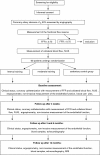Impact of different exercise training modalities on the coronary collateral circulation and plaque composition in patients with significant coronary artery disease (EXCITE trial): study protocol for a randomized controlled trial
- PMID: 22974129
- PMCID: PMC3495905
- DOI: 10.1186/1745-6215-13-167
Impact of different exercise training modalities on the coronary collateral circulation and plaque composition in patients with significant coronary artery disease (EXCITE trial): study protocol for a randomized controlled trial
Abstract
Background: Exercise training (ET) in addition to optimal medical therapy (OMT) in patients with stable coronary artery disease (CAD) has been demonstrated to be superior to percutaneous coronary interventions (PCI) with respect to the composite endpoint of death, myocardial infarction, stroke, revascularization and hospitalization due to worsening of angina. One mechanism leading to this superiority discussed in the literature is the increase in coronary collateral blood flow due to ET. Until now, data demonstrating the positive effect of ET on the collateral blood flow and the functional capacity of the coronary collateral circulation are still lacking.
Methods/design: The EXCITE trial is a three-armed randomized, prospective, single-center, open-label, controlled study enrolling 60 patients with stable CAD and at least one significant coronary stenosis (fractional flow reserve ≤0.75). The study is designed to compare the influence and efficacy of two different 4-week ET programs [high-intensity interval trainings (IT) versus moderate-intensity exercise training (MT) in addition to OMT] versus OMT only on collateral blood flow (CBF). The primary efficacy endpoint is the change of the CBF of the target vessel after 4 weeks as assessed by coronary catheterization with a pressure wire during interruption of the antegrade flow of the target vessel by balloon occlusion. Secondary endpoints include the change in plaque composition as assessed by intravascular ultrasound (IVUS) after 4 weeks, myocardial perfusion as analyzed in MRI after 4 weeks and 12 months, peak oxygen uptake (V02 peak), change in endothelial function and biomarkers after 4 weeks, 3, 6 and 12 months. The safety endpoint addresses major adverse cardiovascular events (death from cardiovascular cause, myocardial infarction, stroke, TIA, target vessel revascularization or hospitalization) after 12 months.
Discussion: The trial investigates whether ET for 4 weeks increases the CBF in patients with significant CAD compared to a sedentary control group. It also examines the impact of two intensities of ET on the CBF as well as the histological plaque composition. The trial started recruitment in June 2009 and will complete recruitment until June 2012. First results are expected in December 2012 (4-week follow-up), final results (12-month long-term secondary endpoint) in December 2013.
Trial registration: Clinical trial registration information-URL: http://www.clinicaltrials.gov.Unique identifier: NCT01209637.
References
-
- Landmesser U, Hornig B, Drexler H. Endothelial function: a critical determinant in atherosclerosis? Circulation. 2004;109:II27–II33. - PubMed
-
- Cannon CP, Weintraub WS, Demopoulos LA, Vicari R, Frey MJ, Lakkis N. et al.Comparison of early invasive and conservative strategies in patients with unstable coronary syndromes treated with the glycoprotein IIb/IIIa inhibitor tirofiban. N Engl J Med. 2001;344:1879–1887. doi: 10.1056/NEJM200106213442501. - DOI - PubMed
-
- Lagerqvist B, Husted S, Kontny F, Stshle E, Swahn E, Wallentin L. 5-year outcomes in the FRISC-II randomised trial of an invasive versus a non-invasive strategy in non-ST-elevation acute coronary syndrome: a follow-up study. Lancet. 2006;368:998–1004. doi: 10.1016/S0140-6736(06)69416-6. - DOI - PubMed
Publication types
MeSH terms
Substances
Associated data
LinkOut - more resources
Full Text Sources
Medical
Miscellaneous


